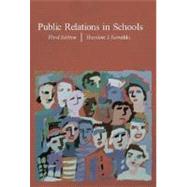
Note: Supplemental materials are not guaranteed with Rental or Used book purchases.
Purchase Benefits
What is included with this book?
| School Public Relations: A New Agenda | |
| Changes in Society and Schools | |
| Public Opinions and Political Contexts | |
| Legal and Ethical Aspects of Public Relations | |
| Social Dimensions of Public Relations | |
| Public Relations in a Communication Context | |
| Programming in Public Schools | |
| Programming in Private and Nontraditional Public Schools | |
| Building Effective Public Relations Plans | |
| Community Relations | |
| Media Relationships | |
| Collecting and Analyzing Decision-Oriented Data | |
| Developing and Executing a Successful Funding Campaign | |
| Responding to Crisis | |
| Evaluating Public Relations Programs | |
| Table of Contents provided by Publisher. All Rights Reserved. |
The New copy of this book will include any supplemental materials advertised. Please check the title of the book to determine if it should include any access cards, study guides, lab manuals, CDs, etc.
The Used, Rental and eBook copies of this book are not guaranteed to include any supplemental materials. Typically, only the book itself is included. This is true even if the title states it includes any access cards, study guides, lab manuals, CDs, etc.